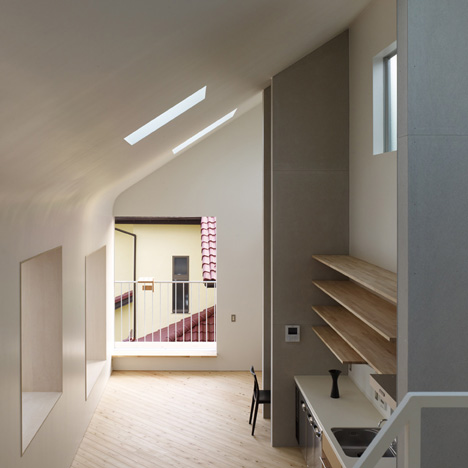This house in Tokyo by Japanese practice Torafu Architects creates built-in furniture through the overlapping of interior spaces.
House in Ookayama is constructed on a narrow plot and has an entrance halfway along the elevation to maximise the size of the rooms, which are all accessed via a central staircase.
A storage space is inserted between the first and second floors and the floor of the living room also extends into the bedroom as a desk.
Photographs are by Daici Ano.
More by Torafu Architects on Dezeen »
More Japanese Houses on Dezeen »
The following is from the architect:
House in Ookayama by Torafu Architects:
A Collection of Large Furniture
Two generations live in this three-storied wooden house located in a Tokyo residential area.
The site corresponds to a 4.7 m wide × 16.5 m long fringe of the land where the owner's parents lived.
Furthermore, the site is enclosed by buildings on three sides while its northern side abuts directly on the street.
The layout was designed to alleviate the impression of narrowness of the frontage in as much as possible and make the best use of the site's conditions within the maximum volume allowed by setback restrictions.
To minimize pressure from the corridor on the frontage path we devised a basic plan that placed the entrance and stairs at the center while the bedroom and public areas are divided on a north-south axis.
Taking into account the fact that the occupants had many belongings, we incorporated a storage space shaped like a box between the 1st and 2nd floors.
Above the bedroom on the 2nd floor is a child's room that resembles a huge table.
Each part is connected by stairs bearing a different design and the space between some of the steps can be used for storage as well.
The floor of the living room on the 2nd floor extends into the bedroom where it serves as a desk.
The toilet in the intermediary storage space protrudes into the 2nd floor to act as a light-well and a table.
The bay window in the wall connecting to the ceiling can also become a bench, giving a sense of loftiness to the whole space. Boards placed between the four sturdy walls passing through the 1st to 3rd floor become shelves and desks that make for a big storage wall by using the structure of the house.
This random-looking composition resembles multifunctional stacking,thus can be seen as one large piece of furniture.
We implemented a cross-section design free from the hierarchical configuration of a normal building, blurring the boundaries between building and furniture.
From the fitting of the terrace to the placement of the shelves and other minute details, we employed a construction method by aggregation, whereby each architectural component becomes a piece of furniture.
This makes the house a vessel that allows for perpetual change to take place and leaves enough leeway for its inhabitants to add their own touch after they move in.

